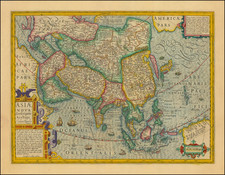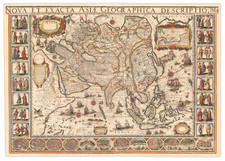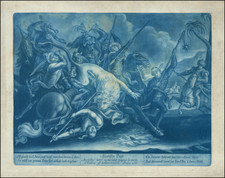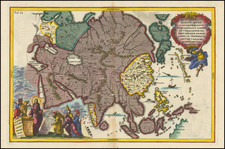L'Asie Dressée Sur les Nouvelles Observations. . . is an impressive 1775 wall map of Asia as understood in the eighteenth century. The product of a collaboration between Jean-Baptiste Nolin the younger, geographer to the French king, and Jean-Baptiste Crepy, a publisher based in Paris, this large wall map stands as a testament to the period's Rococo aesthetics, cartographic practices, and geographical knowledge.
The map, notable for its expansive coverage of the Asian continent, features an array of vignettes depicting biblical scenes, presenting a blending of art and cartography that was characteristic of the period. Augmenting the geographical depiction, the inclusion of the "Description Geographique de l'Asie" and "Description Historique de l'Asie" below the map provides valuable textual information, offering insights into contemporary understanding of the region's geography and history.
An inset in the upper right corner presents a representation of the "Nouvelles Philippines," accompanied by extracts from "Les Lettres curieuses." This feature, indicative of the European interest in remote and exotic regions, offers a glimpse into the historical fascination with the largely unexplored Caroline Islands.
A noteworthy aspect of the map is its representation of the Northwest coast of America, specifically, the region corresponding to today's Alaska, demonstrating the limited knowledge of the area's geography at the time of the map's creation, before the area would be elucidated by Cook and other explorers later in the century.
The detailed labeling of maritime bodies such as the "Mer et Golfe de Coree" and "Mer Septentrionale du Iapon" highlights the precision applied in the map's creation.
States
Initially issued in 1740 by the younger Jean-Baptiste Nolin and reissued in 1749 and 1775, this 1775 edition manifests the evolving understanding of the world's geography. The map stands as a significant artifact for those interested in the historical development of cartography and the evolution of geographical knowledge.
Jean-Baptiste Nolin (ca. 1657-1708) was a French engraver who worked at the turn of the eighteenth century. Initially trained by Francois de Poilly, his artistic skills caught the eye of Vincenzo Coronelli when the latter was working in France. Coronelli encouraged the young Nolin to engrave his own maps, which he began to do.
Whereas Nolin was a skilled engraver, he was not an original geographer. He also had a flair for business, adopting monikers like the Geographer to the Duke of Orelans and Engerver to King XIV. He, like many of his contemporaries, borrowed liberally from existing maps. In Nolin’s case, he depended especially on the works of Coronelli and Jean-Nicholas de Tralage, the Sieur de Tillemon. This practice eventually caught Nolin in one of the largest geography scandals of the eighteenth century.
In 1700, Nolin published a large world map which was seen by Claude Delisle, father of the premier mapmaker of his age, Guillaume Delisle. Claude recognized Nolin’s map as being based in part on his son’s work. Guillaume had been working on a manuscript globe for Louis Boucherat, the chancellor of France, with exclusive information about the shape of California and the mouth of the Mississippi River. This information was printed on Nolin’s map. The court ruled in the Delisles’ favor after six years. Nolin had to stop producing that map, but he continued to make others.
Calling Nolin a plagiarist is unfair, as he was engaged in a practice that practically every geographer adopted at the time. Sources were few and copyright laws weak or nonexistent. Nolin’s maps are engraved with considerable skill and are aesthetically engaging.
Nolin’s son, also Jean-Baptiste (1686-1762), continued his father’s business.













![[Spectacular Set of Wall Maps of the Continents Dedicated to King Charles II of England, &c.]](https://storage.googleapis.com/raremaps/img/small/93614.jpg)
![(Rare copperplate edition!) Asia Secunda Pars Terrae in Forma Pegasi [Asia in the Form of Pegasus]](https://storage.googleapis.com/raremaps/img/small/82046.jpg)

